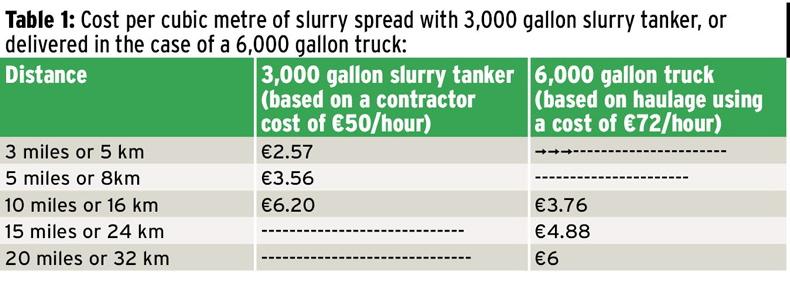The nutrient content of pig slurry is closely related to the solids or dry matter content. Good manure management on the pig farm will ensure minimal dilution with water. This will result in reduced storage and transport costs for the pig producer and a product with higher solids and nutrient content for the customer farmers. Pig manure that contains 4.3% solids is of reasonable quality. Good-quality pig manure will contain more than 5% solids.
The value of pig manure as a fertiliser depends on how much chemical fertiliser is replaced as well as the cost of the chemical nutrients replaced. The fertiliser value of pig manure at 4.3% solids is €5.85 per m3. This translates into €26.59 per 1,000 gallons. A reasonable rule of thumb is that a thousand gallons of pig slurry is equivalent to a bag of 19:7:20.
The EU Good Agricultural Practice for Protection of Waters Regulations were reviewed in 2014 giving some benefits to farmers using pig slurry. The new statutory instrument (SI 31 of 2014) came into effect on 31 January 2014. A number of requirements in these regulations are summarised briefly below:
In order to save money using pig slurry:
If you use chemical P on your farm it will greatly reduce the volume of pig slurry you may use on your farm. Two field demonstrations run by Teagasc in 2014 showed savings of over €100/ha (ie €40 to €50 saved in fertiliser costs per acre).
It is important that you know the volume of pig slurry you may use in compliance with the “nitrate” regulations to ensure maximum savings in fertiliser costs.
Transport costs
Transport and spreading costs should be included when assessing any savings made if using an organic fertiliser. Research at Moorepark modelled the loading, transport and spreading of slurry in different situations of a standard slurry tanker and using a truck to transport the slurry longer distances. These will vary greatly based upon the distance travelled and the tanker size used to draw the slurry.
Table 1 is a summary of the costs involved in transportation of slurry. There are a number of assumptions factored into this model relating to transport speed with full loads on the outgoing journey and empty tanks on the return journeys.

So it is cost effective based on the model assumptions to have pig slurry delivered and spread on land up to nine miles or 14km away from the pig farm (ie the cost to transport it and spread. Likewise the use of a transport truck to deliver it allows the slurry be brought a greater distance from the pig farm – up to approximately 18 miles.
Farmers may save money if they use locally available organic fertilisers effectively to grow their crops. You should get your adviser/consultant to do a fertiliser plan to maximise the potential savings for your farm.
The key decision for the farmer is to ensure transport cost are not greater than the nutrient value of €5.85 per cubic metre.
To read the full Fertilizer Focus Supplement click here.